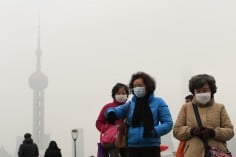
Ozone pollution levels in Shanghai 1.5 times higher than WHO’s recommended limit
Gas now presents bigger health threat to urban residents than PM2.5 particles, but its complex formation makes it much harder to combat

Ozone pollution in Shanghai over the past two weeks has reached levels 1.5 times higher than the WHO’s recommended limit.
The poisonous gas has replaced PM2.5 pollution – particles small enough to enter the lungs – as the biggest threat to the health of residents in several major mainland cities. But experts say ozone pollution, with its complicated formation process, is more difficult to combat than fine particles.
Shanghai saw elevated levels of ozone pollution for 12 straight days, from July 25 to Wednesday, with a peak reading of 246 micrograms per cubic metre recorded on Tuesday, according to the city’s Environmental Monitoring Centre.
The World Health Organisation recommends a limit of 100 micrograms per cubic metre (µg/m³). Exposure to excessive amounts can cause breathing problems, lung disease and trigger asthma.

Ozone was the major air pollutant for 60.5 per cent of all polluted days in the second quarter, compared with 16.9 per cent for PM2.5, the newspaper reported, citing sources at the provincial Environmental Protection Department.
During the same time last year, the figures were 34.1 per cent for ozone and 32.2 per cent for PM2.5.
PM2.5 levels usually fall in the summer, because the weather helps to disperse the particles. But it’s also a time when direct sunlight intensifies, which leads to higher concentrations of ozone pollution.
At ground level, the harmful gas is formed by photochemical reaction of oxygen, nitrogen oxides and volatile organic compounds in the air under sunlight. Nitrogen oxides are produced in combustion processes and emitted by vehicles, power plants that burn fossil fuels and refineries.
He Kebin, a professor of environmental studies at Tsinghua University, said environmental authorities were still trying to decide how to curb levels of hydrocarbons.
Dallas Baker, president of US-based Air & Waste Management Association, said ozone pollution was more difficult to tackle than PM2.5 – which could be removed by installing filters at factories – due to the complicated way it formed.
“One possible solution is to decide which pollution is the more prominent – NOx or organic compounds – in a certain area, then focus on slashing one of the two categories,” he said, referring to nitrogen oxides.
The daily mortality rate rises by 0.3 per cent for every 10 µg/m³ increase in ozone exposure, according to the WHO.
Environmental protection authorities have urged people to avoid daily outdoor activities between 2pm and 3pm, when the ozone concentration is at its highest, according to the Shanghai Morning Post. Unlike with PM2.5, masks do not offer any protection from the gas.
In Hong Kong, ozone remains a serious environmental threat, with the concentration increasing by about a third in the last 15 years, according to government data.